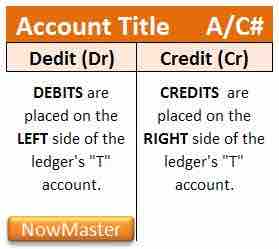Journal entries are business transactions that cause a measurable change in the accounting equation.
(Assets = Liabilities + Stockholders' Equity)
Since business transactions always generate documentation, it is the accountant or bookkeeper's job to analyze the source document to determine whether a journal entry is necessary. Source documents are important because they are the ultimate proof of business transactions. Some examples of source documents include bills received from suppliers for goods or services received, bills sent to customers for goods sold or services performed, and cash register tapes. Each source document is analyzed to determine whether the event caused a measurable change in the accounting equation. If it has, then it is necessary to prepare and record a journal entry in the proper account.
An account is the part of the accounting system used to classify and summarize the increases, decreases, and balances of each asset, liability, stockholders' equity item, dividend, revenue, and expense. Firms set up accounts for each different business element, such as cash, accounts receivable, and accounts payable. Individual companies may label their accounts differently.
All accounts have corresponding contra accounts depending on what transaction has taken place; i.e., when a vehicle is purchased using cash, the asset account "Vehicles" is debited as the vehicle account increases, and simultaneously the asset account "Bank" is credited due to the payment of the vehicle using cash. Some balance sheet items have corresponding contra accounts, with negative balances, that offset them. Examples are accumulated depreciation against equipment, and allowance for bad debts against long-term notes receivable.
The General Ledger
The General Ledger contains all entries from both the General Journal and the Special Journals. Using a double entry system to record transactions keeps the accounts in balance.
The accounting requirement that each transaction be recorded by an entry that has equal debits and credits is called double-entry procedure. This double-entry procedure keeps the accounting equation in balance. For each business transaction recorded, the total dollar amount of debits must equal the total dollar amount of credits. If one account (or accounts) is debited for $100, then another account (or accounts) must be credited for the same amount.
T-accounts
The general ledger of all accounts is, simply, a comprehensive collection of T-accounts -- so called because there is a vertical line in the middle of each ledger page and a horizontal line at the top of each ledger page, like a large letter T. The account title will appear above the horizontal line, and debits and credits will appear to the left and right of the vertical line, respectively.
Some typical accounts and their normal balances:
Assets Debit
Contra Asset Credit
Liability Credit
Contra Liability Debit
Owner's Equity Credit
Stockholder's Equity Credit
Revenue Credit
Contra Revenue Debit
Expenses Debit
Gains Credit
Losses Debit

T-Account
T-accounts are so named because of their "T" shape, with the name of the account on top, and debits and credits on the left and right, respectively.
An account's normal balance will be the side on which increases are recorded. For example, assets and expenses normally have debit balances, and liabilities and revenues normally have credit balances.
Continuing our example, how would we recognize and record the transactions involved in running our yoga studio?
Pre-opening
Prior to opening the business, you make the following transactions:
1. You contribute $4,000 in cash to start the business.
Cash 4,000, Contributed Capital 4,000; Assets(+)=Equity(+)
2. You purchase $500 worth of mats and other equipment for use during classes.
Cash -500, PPE 500; Assets(+), Assets(-)=0
3. You purchase an additional $400 worth of mats, equipment, and clothing for sale at the studio.
Cash -400, Inventory 400; Assets(+), Assets(-)=0
4. You purchase liability insurance at a total cost of $1,200. The policy covers July 1 through December31.
Cash -1,200, Prepaid Insurance 1,200; Assets(+), Assets(-)
July
The following transactions take place during July.
1. You receive cash totaling $800 for classes.
Cash 800, Service Revenue 800; Assets(+)= Equity(+)
2. Your instructor teaches classes for the month. You agree to pay $600 for the classes; $300 is paid on July 15, and $300 will be paid on August 3.
Cash -300, Wage Payable 300, Instructor Expense 600; Assets(-300)=Liabilities(+300)+Equity(-600)
3. You pay rent for July of $1,000 on July 1.
Cash -1,000, Rent Expense 1,000; Assets(-)=Equity(-)
4. You use utilities (electricity and water) totaling $200. This amount is payable on August 15.
Utility Payable 200, Utility Expense 200; Liability(+)+Equity(-)=0.
August
The following transactions take place during August.
1. You receive $1,500 in cash for classes on August 1. Of this amount, $1,000 is for an initiation fee. The remainder is for 2-month passes allowing unlimited classes in August and September.
Cash 1,500, Unearned Revenue 500, Service Revenue 1,000; Assets(+1,500)=Liability(+500)+Equity(+1,000)
2. Your instructor again earns $600 teaching classes; $300 due on August 16 and $300 on September 1.
Cash -300, Wage Payable 300, Instructor Expense 600; Assets(-300)=Liabilities(+300)+Equity(-600)
3. Utilities total $150, payable September 15.
Utility Payable 150, Utility Expense 150; Liability(+)+Equity(-)=0
4. You pay rent of $1,000 on August 1.
Cash -1,000, Rent Expense 1,000; Assets(-)=Equity(-)
5. You sell inventory costing $150 for a revenue of $225.
a. Cash 225, Sales Revenue 225; Assets(+)=Equity(+)
b. Inventory -150, Cost of Goods Sold 150; Assets(-)=Equity(-)
6. You are worried about money, so your Uncle Rafael makes you an offer. He agrees to loan you $2,000 in cash. You will need to repay him sometime later, but he doesn't say when.
Cash 2,000, Loan Payable 2,000; Assets(+)=Liabilities(+)
7. A client is extremely dissatisfied with their class, and demands their money back. Reluctantly, you agree. The class cost $15.
Cash -15, Service Revenue -15; Assets(-)=Equity(-)
8. After borrowing money, you decide to withdraw some of your investment in the studio to pursue other opportunities. You decide to withdraw $1,000.
Cash -1,000, Contributed Capital -1,000; Assets(-)=Equity(-)